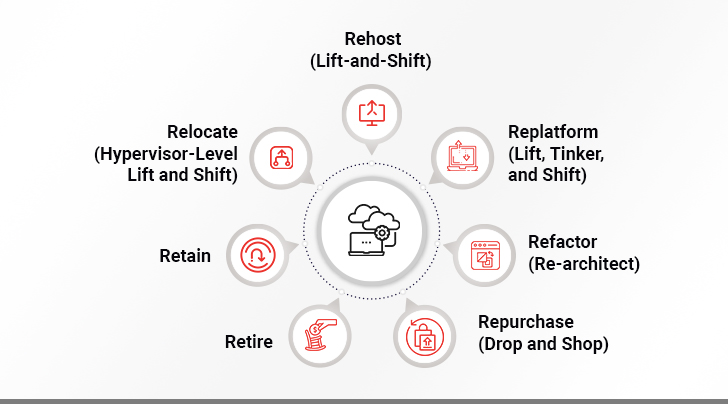What do you think is the prime reason organizations move to the cloud? Is it because of security and data concerns? Is it due to the rising need to modernize data storage facilities? Or is it to reduce costs and enhance the performance of IT operations?
While you assess this information, let us share another critical insight about the global cloud computing market size. That it is expected to grow from USD 626.4 billion in 2023 to USD 1266.4 billion by 2028– thanks to significant advancements from leading cloud service providers including Google, Amazon, IBM, and Microsoft.

Fueled by this bouquet of benefits, businesses tend to try out new technologies without adequate due diligence – as a result, a large number of users consider switching Cloud vendors in a few months. It counters the intended impact of cloud adoption, but the lack of sustainability also negatively affects ROI margins. Therefore, it’s essential to carefully formulate an enterprise cloud migration strategy that encapsulates parameters like available technology resources, human talent, security paradigm, resilience requirements, and future adaptability, among others. Understanding these in greater detail is the first step towards inking a cloud migration roadmap in today’s crowded marketplace. From the global giants mentioned above to clusters of local cloud service providers, there are various options to choose from, so finding the proper methodology aligned to a particular business is critical.
Let’s now take a closer look at some popular cloud migration strategies.
The 7 Rs of Cloud Migration

I. Rehost (Lift-and-Shift)
Rehosting means moving applications from local servers to the cloud with minor changes. This method helps companies quickly transfer their workloads to the cloud. The main benefit of rehosting is that it is fast, allowing businesses to meet their immediate needs without changing the applications much. This is especially helpful for older systems that need to move quickly to stay relevant. However, while it is simple, it might not take full advantage of cloud features, which could limit future improvements.
II. Replatform (Lift, Tinker, and Shift)
Replatforming means making some changes to applications during the move to the cloud, so they use cloud features without completely rewriting them. This method helps improve performance and lower costs by optimizing parts like databases while keeping the main structure.
For example, a company might move its application to a cloud-managed database to improve how it scales and reduce management work. Replatforming is a good mix of rehosting and refactoring, making it a popular choice for companies that want quick benefits from the cloud while getting ready for future upgrades.
III. Refactor (Re-architect)
Refactoring, or re-architecting, means making bigger changes to applications to fully use cloud features. This includes complete redesigning of applications to work smoothly in the cloud. It is usually required when companies need to roll out new features or improve the existing ones. This cloud migration approach may take a lot of time and money, but it certainly offers long-term benefits. Companies that choose this migration approach are poised to maximize their cloud investments.
IV. Repurchase (Drop and Shop)
Repurchasing means moving from traditional software licensing to a SaaS model. This method is ideal for companies that want to replace old applications with new cloud-based ones. For example, a business might stop using its old customer management system and switch to a cloud-based service.
The repurchase strategy allows companies to enjoy the latest features without having to manage the underlying technology. This simplifies operations and lowers maintenance costs, making it a good choice for businesses that want to modernize their software while making the move easier.
V. Retire
The retire strategy means getting rid of applications that are no longer useful. During the migration assessment, companies may find some applications that don’t add enough value or are no longer needed. By retiring these applications, businesses cut costs, simplify their IT setup, and focus on more important systems. This strategy is key to improving the overall cloud setup and making sure only valuable applications are moved, leading to a more efficient and cost-effective cloud environment.
VI. Retain
Retaining means keeping certain applications on local servers. It is ideal for organizations that have specific regulations that require keeping some workloads on-premises. This approach helps businesses enjoy the benefits of cloud migration while still controlling important systems. For example, sensitive data that must follow strict rules may stay on local servers to ensure safety and compliance. The retain strategy recognizes that not all applications should be moved to the cloud and allows companies to make smart decisions about their IT setup.
VII. Relocate (Hypervisor-Level Lift and Shift)
Relocating is a newer method that involves moving workloads from local virtual systems to cloud-based ones without major changes. This strategy reduces downtime and disruption because it allows companies to move whole groups of servers easily. For example, moving a VMware setup to a cloud service that supports VMware makes the process smoother. Relocating is helpful for organizations that want to keep things running smoothly while moving to the cloud, as it needs little retraining and investment, making it a cost-effective choice for many businesses.
Key Points to Consider Before Taking a Plunge into Cloud Migration
Best Practices for Maximizing Cloud Migration ROI
1. Assess and Prioritize Workloads
Evaluate your existing applications to determine their feasibility for cloud migration. Prioritize them based on their dependencies, complexity, and business value. Start with the least critical functions to minimize disruption and gain experience before tackling more essential workloads.
2. Create a Dependency Mapping
Identify and understand the interdependencies among applications, servers, and data. This helps avoid disruptions, performance issues, or failures in the cloud environment by ensuring all dependencies are considered during migration.
3. Develop a Detailed Migration Plan
Create a comprehensive migration plan that outlines the timeline, resources, tasks, and cloud architecture. Address compliance and security requirements to ensure a smooth transition.
4. Choose the Right Migration Strategy
Leverage the 7 R’s framework to select the most appropriate cloud migration approach for each workload:
- Rehost (Lift-and-Shift): Move applications to the cloud with minimal changes for a quick migration.
- Replatform (Lift, Tinker, and Shift): Make some cloud optimizations without major changes to gain immediate benefits.
- Refactor (Re-architect): Redesign applications to fully leverage cloud-native features for long-term optimization.
- Repurchase (Drop and Shop): Replace legacy applications with cloud-based SaaS solutions.
- Retire: Decommission applications that are no longer needed to reduce costs.
- Retain: Keep certain applications on-premises due to compliance, regulatory or operational requirements.
- Relocate (Hypervisor-Level Lift and Shift): Move entire server collections from on-premises to cloud-based equivalents.
5. Conduct Rigorous Testing
Make a detailed testing plan that entails data, performance, and user acceptance. Make sure the migrated data matches with the original data exactly.
6. Prepare a Solid Backup Plan
Implement a robust backup strategy before migration to protect against data loss or corruption. Ensure data remains securely copied without removal from the source cloud during migration.
7. Optimize for Cost and Performance
Monitor and optimize the cloud environment for cost-efficiency and improved performance. Look for unique ways to make the most of cloud services and make required changes to maximize your ROI.
10 Key Parameters on Your Cloud Migration Checklist
I. Data Center Location
A country might have explicit laws around data sovereignty which prohibit the transfer of specific data types to offshore locations. In that case, a locally available data center will be required to avoid fines and penalties in the longer run. This is a critical factor determining vendor selection but is often overlooked at the assessment stage if more weightage is given to cost and infrastructure components.
II. Storage and Archival
Robust data archival capabilities are among the biggest motivators for moving to the cloud, making businesses immune to infrastructure attacks. How fast and accurate business data is received will underline the success of any cloud migration. Every provider will have its own governance rules and archival features for data recovery during disaster events.
III. Security Ripples
Detractors of cloud implementation often cite security vulnerabilities as a primary reason for holding on to on-premise systems. Taking sensitive data and core business applications to a distributed, always-connected environment means there could be more vulnerabilities and additional touchpoints for cyber attacks. Before migration, therefore, it is essential to conduct end-to-end impact analysis, assessing for any disturbance in business workflows and security checkpoints.
IV. Resilience Objectives
24/7 service availability is among the primary motivators for adopting cloud technology. However, this isn’t always the case. Consider the 2017 global outage when Amazon Web Services suffered a prolonged downtime impacting thousands of businesses worldwide. Not only should uptime requirements be mentioned in the SLAs, but a provider should also be validated for high resilience, response times, and the ability to recover before making the shift.
V. Solution Component Set
There’s no one-size-fits-all cloud environment that’s ready to take on any use case. The cloud provider mix available will also differ accordingly, bringing a comprehensive set of solutions and services and scalability and resilience features to the customer. Expectations must be communicated at the get-go to align services to the required environment type – multi-vendor, public, or a private-public hybrid scenario.
VI. Unique Configurations
Depending on the size and nature, customers may look for specific configurations and a high degree of adaptability from their cloud provider. A healthcare major, for example, may look for dedicated tenancy and more excellent security controls to help operate as a pseudo-private cloud. The solution should also be ready to support the standard SaaS products (Salesforce, SAP, etc.), which are likely to be part of most technology stacks.
VII. Vendor Lock-in
The inherent flexibility of the cloud is what’s drawing both small and large businesses alike to this new environment. In this context, a customer must easily opt-out, switch providers, or return in-house at relatively short notice. This means that applications developed on the cloud (cloud-native) shouldn’t be coupled to a specific provider, and this needs to be incorporated into the SLAs.
VIII. Operational SLAs
When initiating any digital transformation project, the customer’s existing Service Level Agreements mustn’t be compromised. The assessment stage should identify provider constraints that could influence business SLAs and hold back improvement targets. The cloud computing migration strategy should take all of this into account and prescribe independent service dashboards which should be used to resolve any post-implementation conflict around SLA adherence.
IX. Accreditation Due Diligence
With so many cloud providers available in the market, it is imperative that organizations carefully audit prospective partners before finalizing their migration strategy to the cloud. To take from our earlier example, a healthcare business (whether it’s a clinic or a hospital chain) would likely store Personal Identifiable Information on the Cloud, making specialized certifications mandatory, in addition to the more widespread GDPR.
X. CI/CD capabilities
To ensure implementation is rapid and agile, quickly adapting to emerging requirements and testing results, the cloud service provider should offer Continuous Improvement/Continuous Delivery capabilities. This will help complete the project in an agile mode, completing the transition within set timelines and ROI targets. Simply choosing a basic application install and set-up without Cloud-native development competencies is not recommended.
Calculating the Cloud Migration ROI
An expertly calculated cloud application migration strategy will always balance the technology costs incurred and FTE investments with the potential gains derived from the cloud. Research suggests that cloud-hosted SaaS applications help generate 1.7 times greater ROI than on-premise applications– this is mainly because the provider offers upgrades and improvements over time as part of original SLAs, without any additional spending. To calculate the ROI of cloud app migration, you may simply use the formula given below:
ROI Calculation FormulaThe basic formula for calculating ROI is:
ROI = ((Total cloud value – initial value of investment) / cost of investment) x 100%
There are minimal upfront costs for hardware or infrastructure in the near term, while operational efficiencies will continually increase in the long run. This, combined with the benefits we outlined at the start, is precisely why the cloud is emerging as the new normal, transforming businesses across sectors, sizes, and IT maturity levels.
To explore cloud possibilities at your organization and formulate an individualized migration strategy, talk to our cloud migration strategy consulting experts.





